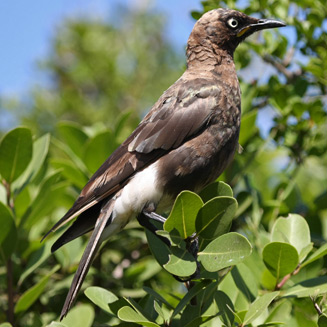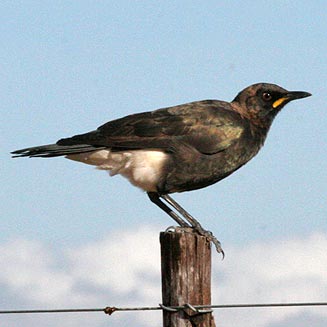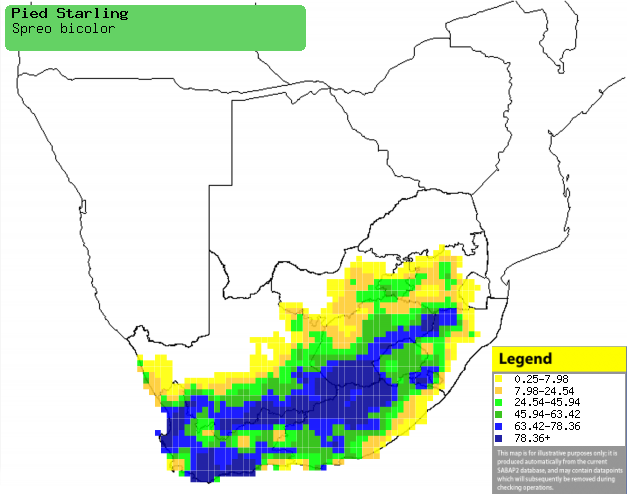|
Spreo bicolor (Pied
starling)
Witgatspreeu [Afrikaans]; Igiwu-giwu, Igiyo-giyo
[Xhosa]; iGwayigwayi, iKhwikhwi, iNgwangwa [Zulu]; Leholi (generic term for
starlings) [South Sotho]; Tweekleurige glansspreeuw [Dutch]; Spréo bicolore
[French]; Zweifarbenstar [German]; Estorninho-de-ventre-branco [Portuguese]
Life
> Eukaryotes >
Opisthokonta
> Metazoa (animals) >
Bilateria >
Deuterostomia > Chordata >
Craniata > Vertebrata (vertebrates) > Gnathostomata (jawed
vertebrates) > Teleostomi (teleost fish) > Osteichthyes (bony fish) > Class:
Sarcopterygii (lobe-finned
fish) > Stegocephalia (terrestrial
vertebrates) > Tetrapoda
(four-legged vertebrates) > Reptiliomorpha > Amniota >
Reptilia (reptiles) >
Romeriida > Diapsida > Archosauromorpha > Archosauria >
Dinosauria
(dinosaurs) > Saurischia > Theropoda (bipedal predatory dinosaurs) >
Coelurosauria > Maniraptora > Aves
(birds) > Order: Passeriformes
> Family: Sturnidae
 |
 |
|
Pied starling, De Hoop Nature Reserve, Western
Cape. [photo
Duncan Robertson ©] |
Pied starling, West Coast Fossil Park, Western Cape, South Africa. [photo H. Robertson,
Iziko ©] |
Distribution and habitat
Endemic to South Africa, Lesotho and Swaziland, generally
preferring open habitats with lots of grass, such as cultivated areas, grassland
and rural settlements, but generally avoiding larger cities and towns.
|
 |
|
Distribution of Pied starling in southern Africa,
based on statistical smoothing of the records from first SA Bird Atlas
Project (©
Animal Demography unit, University of
Cape Town; smoothing by Birgit Erni and Francesca Little). Colours range
from dark blue (most common) through to yellow (least common).
See here for the latest distribution
from the SABAP2. |
Predators and parasites
It has been recorded as prey of the following birds:
Brood parasites
It has been recorded as host of the
following birds:
Food
It mainly eats arthropods, supplemented with seeds, fruit
and nectar, doing most of its foraging on the ground. It often associates with
livestock, catching the prey they disturb and removing ticks from their skin. The following food items have been recorded
in its diet:
- Animals
- Plants
- Miscellaneous
Breeding
- Monogamous, usually colonial cooperative breeder, nesting either
solitarily or in colonies ranging from a few pairs to several thousand
individuals. The breeding pair are typically assisted by up to 7 helpers,
who are either immature or unmated adults, often becoming the mate of a bird
previously assisted in an earlier breeding season.
- Egg-laying season is year-round, peaking from August-January.
- It lays 2-6 eggs, which are incubated solely by the female for about
14-16 days.
- The chicks are fed by parents and helpers, leaving the nest after about
23-27 days; helpers continue to feed them for about a week more before they
become independent.
Threats
Not threatened.
References
-
Hockey PAR, Dean WRJ and Ryan PG 2005. Roberts
- Birds of southern Africa, VIIth ed. The Trustees of the John Voelcker
Bird Book Fund, Cape Town.
|
